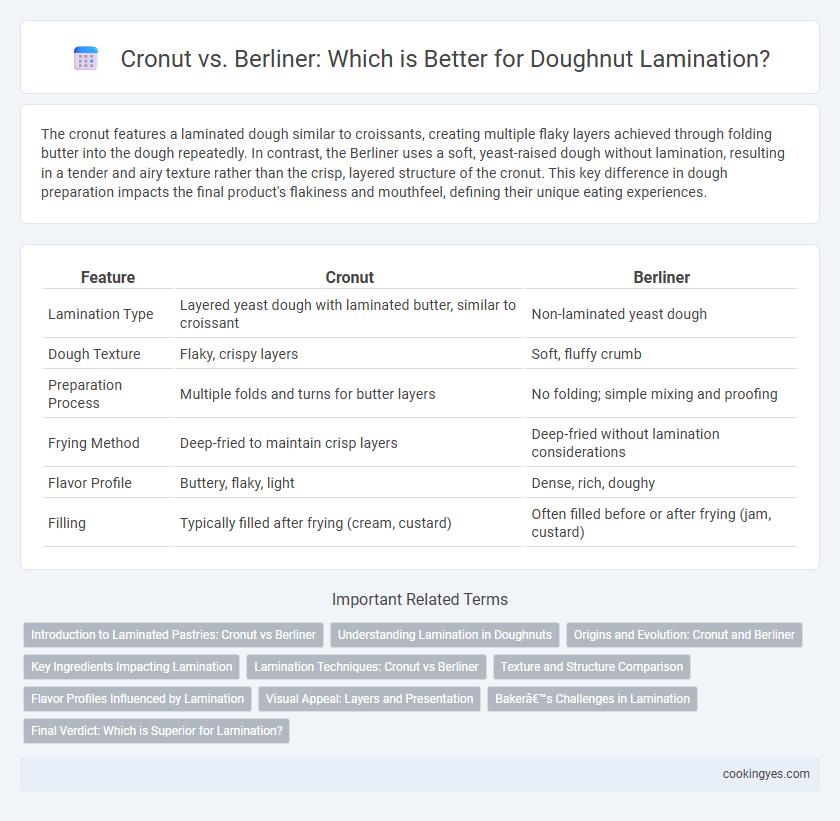The cronut features a laminated dough similar to croissants, creating multiple flaky layers achieved through folding butter into the dough repeatedly. In contrast, the Berliner uses a soft, yeast-raised dough without lamination, resulting in a tender and airy texture rather than the crisp, layered structure of the cronut. This key difference in dough preparation impacts the final product's flakiness and mouthfeel, defining their unique eating experiences.
Table of Comparison
| Feature | Cronut | Berliner |
|---|---|---|
| Lamination Type | Layered yeast dough with laminated butter, similar to croissant | Non-laminated yeast dough |
| Dough Texture | Flaky, crispy layers | Soft, fluffy crumb |
| Preparation Process | Multiple folds and turns for butter layers | No folding; simple mixing and proofing |
| Frying Method | Deep-fried to maintain crisp layers | Deep-fried without lamination considerations |
| Flavor Profile | Buttery, flaky, light | Dense, rich, doughy |
| Filling | Typically filled after frying (cream, custard) | Often filled before or after frying (jam, custard) |
Introduction to Laminated Pastries: Cronut vs Berliner
Laminated pastries involve repeated folding and rolling of dough with layers of fat, creating a flaky, airy texture distinct in both Cronuts and Berliners. Cronuts blend traditional croissant lamination techniques with doughnut frying, producing crisp, buttery layers unlike the Berliner, which uses a softer, non-laminated yeast dough. This structural difference defines the Cronut's signature flakiness compared to the Berliner's dense, pillowy interior.
Understanding Lamination in Doughnuts
Lamination in doughnuts involves folding butter into dough to create distinct flaky layers, a technique integral to both Cronuts and Berliners but applied differently. Cronuts undergo multiple folds and turns similar to croissant dough, resulting in a delicate, airy texture with visible layers. Berliners use a softer, enriched yeast dough with less emphasis on lamination, producing a denser, cake-like crumb with a smooth exterior.
Origins and Evolution: Cronut and Berliner
The Cronut, invented in 2013 by Dominique Ansel in New York City, combines the laminated dough techniques of a croissant with the frying method of a doughnut, resulting in a flaky, layered texture unique in modern pastry innovation. The Berliner, originating in Germany in the 16th century, is a classic yeast doughnut without lamination, traditionally filled with jam or custard and reflecting centuries of European baking evolution. While the Cronut's lamination process creates distinct buttery layers similar to croissants, the Berliner maintains a softer, denser crumb due to its unlaminated dough, highlighting differing approaches in dough preparation and culinary heritage.
Key Ingredients Impacting Lamination
The croissant-dough hybrid known as the cronut relies heavily on laminated dough made from high-fat butter and precise layering, creating its signature flaky texture and delicate crispness. In contrast, the Berliner utilizes a simpler yeast dough without lamination, focusing on a soft, pillowy crumb rather than layers, which impacts its mouthfeel and overall structure. Key ingredients such as unsalted butter for lamination in cronuts versus enriched yeast dough components like eggs and milk in Berliners directly influence the dough's elasticity, rise, and final texture.
Lamination Techniques: Cronut vs Berliner
Cronut lamination involves a hybrid technique combining croissant-like folded butter layers with doughnut dough, resulting in multiple thin, flaky layers that create a crisp exterior and tender interior. Berliner lamination is simpler, typically using a yeast-raised dough without extensive butter folding, which produces a soft, airy texture without the distinct layers found in cronut. The cronut's meticulous lamination achieves a delicate, buttery flakiness, while Berliners rely more on yeast fermentation for their light, pillowy crumb.
Texture and Structure Comparison
The cronut features a flaky, layered texture due to its laminated dough, combining the lightness of croissants with the softness of doughnuts, resulting in a crisp exterior and tender interior. In contrast, the Berliner uses a non-laminated yeast dough that produces a denser, softer crumb with a uniform, airy structure and no flaky layers. Lamination in cronuts creates distinctive layers that enhance crunch and flakiness, whereas Berliners rely on fermentation for a pillowy, smooth texture.
Flavor Profiles Influenced by Lamination
Lamination creates distinct texture and flavor differences between the Cronut and the Berliner. The Cronut's multiple layers of buttery, flaky pastry impart a rich, airy bite with a subtle sweetness that complements its often fruit or custard fillings. The Berliner, with fewer laminated layers and a denser dough, offers a soft, tender crumb and a slightly yeasty flavor, enhanced by its traditional jam or cream fillings.
Visual Appeal: Layers and Presentation
The cronut features distinct, visible layers created through multiple folds of laminated dough, giving it a flaky, golden-brown texture that enhances its visual appeal. In contrast, the Berliner, made from a soft, yeast-raised dough without lamination, presents a smooth, uniform surface with a powdered sugar or glaze finish. The cronut's intricate layers highlight the craftsmanship of its lamination, making it visually more complex compared to the Berliner's simpler, rounded appearance.
Baker’s Challenges in Lamination
Cronut lamination requires precise temperature control and consistent dough elasticity to achieve the delicate, flaky layers that define its hybrid structure, posing challenges for bakers in maintaining uniform lamination without tearing. Berliner dough, traditionally unlaminated, poses fewer lamination difficulties but demands careful handling to achieve softness and even crumb texture through proofing and frying. Balancing moisture content and lamination timing is critical for Cronut production to prevent dough shrinkage and ensure optimal rise and flakiness.
Final Verdict: Which is Superior for Lamination?
The cronut excels in lamination due to its hybrid technique combining croissant dough layers with deep-frying, resulting in a crisp, flaky texture and distinct buttery flavor. Berliners, while soft and airy, lack the multi-layered lamination structure, offering a denser crumb without the characteristic flakiness. For superior lamination and textural complexity, the cronut is the definitive choice among laminated doughnuts.
Cronut vs Berliner for Lamination Infographic

 cookingyes.com
cookingyes.com